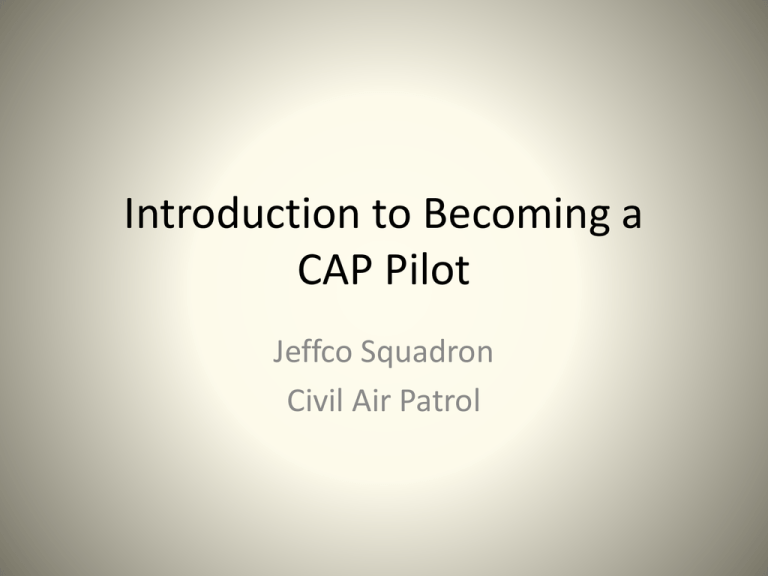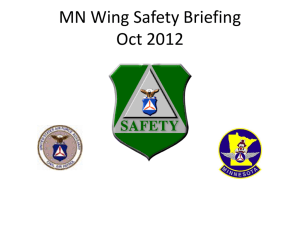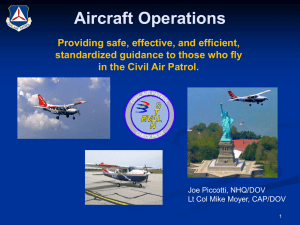CAPF 5 Primer Course
advertisement

Introduction to Becoming a CAP Pilot Jeffco Squadron Civil Air Patrol Pilot Application Process • • • • • • • Must have high-performance endorsement Complete CAPR 60-1 annual exam Complete RMR pilot application Sign Statement of Understanding Complete CAPF 5 (and check ride) Complete at least one aircraft questionnaire 100 hrs. logged total time CAP Form 5 Limitations • Cannot fly non-CAP members • Cannot fly out of state (there are some exceptions) • Cannot keep plane overnight (there are some exceptions) • Cannot fly for reward or hire • Cannot land off-airport (no dirt/grass runways) After your CAPF 5 check ride • Obtain Emergency Services (ES) qualifications, if you haven’t already • Orientation ride pilot “O-ride Pilot” (200 hrs PIC) • Transport mission pilot “TMP” (150 hrs PIC, 50 X-C) • Mission Pilot “MP” (200 hrs PIC) – MP allows you to seek more ratings through CAP Aircraft • N594CP – – – – 2009 C-182T IO-540 50 gallons mission fuel to allow a crew of 3 GW: 3100 takeoff weight; 2950 landing weight • N9669X – – – – 1986 C-182R O-470 60 gallons mission fuel GW: 3100 takeoff weight; 2950 landing weight Hangar • Jeffco Squadron manages N594CP in Hangar 51 • Boulder Squadron manages N9889X in Hangar 42 • Hangars have very tight tolerances for wings and tail. – Use 2 or 3 people. – Go slowly – Ensure the airplane doesn’t pivot as it roles over the door tracks. – Use winch if solo. N594CP Ops Reminders • • • • • CAP Airplanes require 100 hour inspections, among others. Check the front page of the Aircraft Information File There are three oxygen couplers (w/flow meters) in the oxygen tank’s bag. Use them, but don’t take them. Cost is $150.00 each! A fuel gauge pipette is supplied with the aircraft, kept in pilot seat-back pocket. The attached foam ball is to prevent the pipette from going inside the tank. Use the pipette to measure the fuel after flight so you know how much to add. A tie-down kit is in a plastic grocery bag in the back of the airplane. It is the pilot’s responsibility to keep the aircraft clean. Most cleaning materials are now labeled: – Plexus” aerosol is for cleaning windshield and landing light lens – “Arrow Magnolia” aerosol is for cleaning cloth, leather, and plastic interior surfaces – Spray bottle with blue fluid is for cleaning metal aircraft skin (belly, leading edges, etc). Each bottle is filled with a 50/50 mix of water and Simple Green degreaser. – Monster pump-spray cleaner is for G1000 display – Eagle One “wadding” is for cleaning the spinner • • • Do not overfill oil. 6 quarts normal, 8 for extended flights Hangar door wheels occasionally become derailed. Contact airport maintenance or crew chief; do not attempt to re-rail hangar doors. C-182T G1000 POHs available for $35 ea. Contact Todd Gamber (720-560-6737) for details. Fuel • Fuel can be purchased from Denver Air – 122.95 – 800-525-8139 • MultiServ Card can be used for fuel • N594CP – jeffcosquadron@gmail.com – pw = Jeffco136 • N9669X – bouldersquadron@gmail.com – pw = Boulder072 VFR Common Problems • Not prepared for the checkride – Unfamiliarity with POH & installed equipment • Airplane out of trim • Airspeed control – No list of target airspeeds • “Jockeying” power with a constant speed prop • Lack of a defined crosswind procedure—slip or kick straight method? – Inability to execute the procedure • Fixation with radio calls in the traffic pattern • Checklists • Unfamiliarity with audiopanel & installed Nav systems (not GPS) – Unfamiliarity with GPS is not a CAPF5 problem, though it is a CAPF91 problem • VFR goal: Be able to fly the aircraft hands-off during most flight regimes IFR Common Problems • • Airplane out of trim “Jockeying” power – – • know the power setting for straight & level flight at the approach speed know the power setting for descent on the GS Getting behind the airplane – Airplane not slowed down in time • – Radios not set up • • • • If you are not low, the DG is the most important instrument on an ILS • • know the heading & set the DG outside the marker If you are low, the GS is the most important instrument—pull up! Position of GPS/VLOC switch Fixation on setting GPS Inability to prioritize tasks – • Maker beacon not turned on No method to determine position while on vectors Weather Fixation on airspeed and timing of an ILS – • • • Late to descend and too fast Difficulty doing many things at once Instrument goal: 8 out of 10 ILSs should be perfect—10 out of 10 should be safe. Proficiency Flying • A CAPF5 provides you the privilege of using CAP aircraft for proficiency flying such as: – Takeoffs and Landings – Instrument Approaches – Checkride Preparation • Subject to certain provisions, training in furtherance of a certificate or rating is allowed • C-182s are $70 per hour • CAP instructors are unpaid WMIRS • • • • • http://missions.cap.af.mil Schedule aircraft Obtain reports Notify USAF of our operations Required for every flight Resources • CAP Regulations: http://www.capmembers.com/forms_publications__regulations/indexes_ regulations_and_manuals.cfm • CAP Forms: http://www.capmembers.com/forms_publications__regulations/forms.cf m • CAPR 60-1 Exam: www.capmembers.com/emergency_services/stanevalflight_ops/index.cf m • CAPR 60-1 RMR supplement and Pilot Application form http://www.rmrcap.us/index.php?option=com_rokdownloads&view=folde r&Itemid=165&id=57:publications-supplements-forms • Hangar Safety Survey: http://www.coloradowingcap.org/jeffco (then go to Air Operations) • G1000 POH and other materials: http://www.toddgamber.com/g1000 Revision History Date Version Editor Notes 29 Feb 2012 Original Capt Joseph Friel Initial revision 1 Mar 2012 v1 Capt Todd Gamber Added “Aircraft questionnaire” to ‘Pilot Application Process’ sheet 3 Mar 2012 v2 Capt Todd Gamber Removed “100 hours PIC” requirement from ‘Pilot Application Process’ sheet 14 Mar 2012 v3 Capt Todd Gamber Added “100 hours total time” to the Pilot Application Process slide. Required for any high performance CAP airplane per CAPR 60-1.











